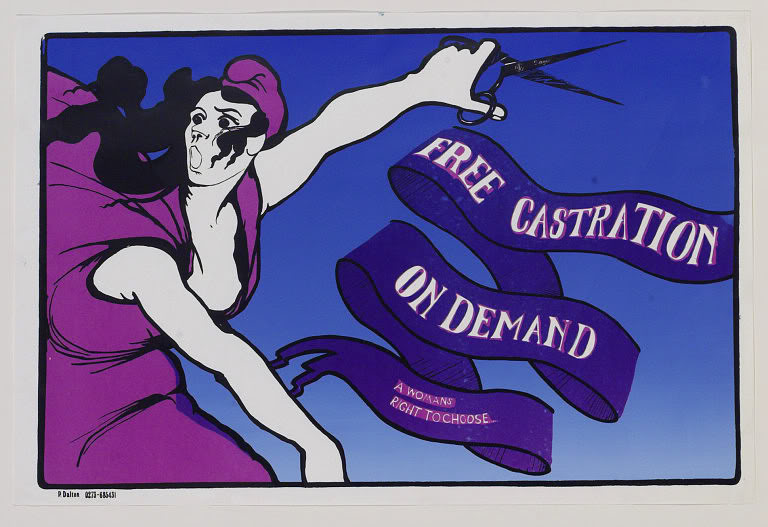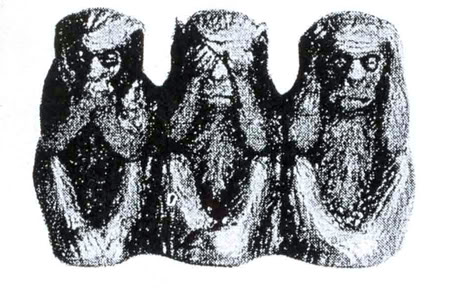Lecture No. 6
“Whatever crushes individuality is despotism, by whatever name it may be called” – J. S. Mill
Domination. So much of feminist analysis revolves around this concept. A man who punches his wife is not just angry at her; he is attempting to dominate her. A man who disagrees with a woman and talks over her is not just being rude; he is trying to dominate her. A rapist is not really that bothered about sex; his crime is a display of power, he just wanted to dominate the woman.
You see, the fact that these things happen at all is not enough for the male-bashers of the world; they shall forever require more grist for the misandric mill. Punishing actual criminals is one thing, but it’s simply not gratifying enough to leave it there – they need to articulate what their womyn’s intuition has always told them, and go on the attack against all men. The problem, of course, is that the overwhelming majority of men don’t attack women in any perceptible way whatsoever. The solution, as feminists found, is to play Dr. Freud and posit some subconscious, underlying motivation – a dark, sexual, deviant, violent mentality, which acts as a universal explanation for male behavior.
You see, even when men are not actually engaging in criminal acts, the criminality is still there, it is just latent – so the feminists would have us believe. The idea that all men possess an inherent, latent evil, and that women do not, serves as a useful cover for all sexist hate speech against men. We find it at work in senseless diatribes against a non-falsifiable “rape culture,” in campaigns to prohibit the private consumption of pornography, and in apologia for malicious women who falsely accuse men of sex crimes. Consider this statement from Mary Koss: “rape represents an extreme behavior but one that is on a continuum with normal male behavior within the culture.”
Inherent male deviancy, so they say (or imply), manifests as a continuum of dysfunctional maleness, covering everything from a simple verbal disagreement, all the way up to the murder of a spouse. All male actions which do not contribute towards the feminist project – increasing the power of women – are to be taken as evidence of an innately flawed masculinity which seeks, above all, to dominate the fair sex.
Put it this way. Would you say that being murdered helps to increase a woman’s power?
No?
Well, what about losing a verbal sparring match – does this help to increase her power? Or doesn’t it? It certainly seems that one will have greater autonomy if she can more easily convince others that her view is correct.
So, if both of the above examples exist on a continuum of women losing power, the corollary of which is patriarchal domination, then of course men are to blame. That is, if our analysis is based in dubious, feministic assumptions.
The concept of domination, so taken for granted in its present manifestation, is a supreme example of the linguistic shifting I have discussed previously. As a term, it carries ideological contraband, concealed in an overcoat of righteousness. Originally, the term domination, which has its root in the Latin dominus, referred specifically to the power exercised by a master over slaves. Like so many other terms that feminists have seized upon in order to manipulate perceptions of reality, domination has become an object of semantic bleaching.
What is really interesting about all this, is that our new concept of domination – as unjust hierarchy, to be opposed and attacked – has been put to use in a specific direction: as a sponsor for true despotism. The single most obvious red flag marking the road to despotic rule is the encroachment of the public sphere into the private lives of individuals. Despotism is precisely the type of unjust hierarchy with which we identify domination; yet if the latter term is broadened sufficiently, to encompass all areas of private life, then a crushing and brutal dictatorship is the inevitable result.
This is the context in which we should understand the feminist slogan which has had the most staying power: the personal is political. Note that (according to the slogan), the personal is not only a matter of interest to the political; it does not form part of the political; it is not of equivalent importance to the political. It actually is the political.
The two terms are presented as though they are identical, interchangeable.
The personal is political.
If this is true, then there does not exist the smallest space of privacy which is a matter for the individual alone – that is, over which the individual is sovereign. It is true enough that a private life worth anything would not be possible without an overarching public structure – it is law which protects all the liberties that make private lives and interests possible. To use J. F. Stephen’s favorite analogy, law is the pipe through which the waters of liberty flow. It is when public life – the state – fails to recognize its own limits that society becomes threatened by despotic rule.
Intellectuals of all ages have come up with the most ingenious of reasons for why it is that their mode of thought is superior to all that passed before. The majority of people have simply assumed this without the need for justification whatsoever. What is peculiarly modern is the construction of artificial boundaries between our own time and epochs past. We do not, for instance, consider ourselves to be living on the same historical plane as those of Medieval Europe, let alone of Ancient Greece. These are times inexplicable and inaccessible to us. It is a seductive fantasy by which we explain away any fears conjured up by the horrors of history books. We like to believe that bloody autocracies will confine themselves safely to those pages, and that such things could not happen here, not now; not in real life. Surely, we have moved beyond all that. We are Enlightened, unlike the human beings that existed before us.
But are we not on the same historical plane that gave rise to Soviet Communism and the Nazi party? These particular reigns of terror occurred within the last century, no matter how much we might like to think of ourselves as having progressed beyond such barbarism. Supposedly, we in the Western world abhor totalitarian regimes; and yet the rise of the two mentioned previously is indicative of a trend existing within our political culture. Among the baggage we have inherited from the Enlightenment is the concept of utopia. The term was coined in the 16th century, and it designated, for the first time, the notion of a perfect socio-political order. With the birth of this idea, the seeds were sown for the cleansing of human impediments as an operationalized political program.
Prior to the Enlightenment, human life was mostly assumed to be cyclical. As surely as the sun would rise in the morning and set once more in the evening, so great powers would rise and fall, only for new ones to take their place. Such was the science of Polybius, whose historical works did not arrange events in chronological order, but presented human experience as a unity. Dynasties, empires, cultures, people and their communities lived and died in the swings of the cosmic pendulum.
One of the major conceptual innovations of modernity is progress as the guiding ideal in politics and society. Not only do we assume that we are constantly on the move away from our own history; the belief persists that it is only a matter of time before each problem yields to a solution. Faith in human knowledge has never been so great as in the Information Age; we actively seek to overcome what were long considered intractable facts of life.
The purpose of this digression is not to cast doubt over the possibilities for human knowledge, nor to suggest that an attempt to improve the human condition is an ignoble pursuit. It is to point out that we are all children of the Enlightenment, no matter where we fall on the political spectrum. It is to point out that there are certain peculiar assumptions which form the base and scaffolding of Western political thought, and it is upon these assumptions that ideologies as diverse as conservatism, liberalism, National Socialism and feminism are built.
The -ism itself is an altogether modern phenomenon. An -ism (or we might say, an ‘ideology’) assumes a difference between how society is and how it ought to be, predicated upon a specific moral view of the world. This is obviously true for those ideologies explicitly advocating change – liberalism, socialism, feminism, and so on. It is just as true for conservatism and traditionalism, ideologies which (as they see it) aim to resuscitate the baby that has been thrown out with the bathwater of the ages.
Typically, that which ideologues find so objectionable about the world is its existing configuration of power. The great texts and speakers of the ideology describe a configuration of power, argue for its recognition as injustice, and then present the means for achieving the desired change. The means may involve working through the existing institutions of state, or they may necessitate their overthrow, or they may shun mainstream practices altogether and advocate working their magic through civil society.
Whatever the ideology implies in practice, this is a marked difference from what went before. Progress, not recurrence, is at root of all political expectation. Whether this is progress towards the classless society, or ethnic purity, or the return of traditional virtues, progress is the constant. The view that something is wrong and something needs to be done about this, as a political statement, is a recent invention, one which defines our shared political culture. Conservatives are caught up in the same ‘progressive’ web, but then, so too are iconoclasts, who signal their compliance with conventional modes of thought even as they state their intentions to break away. The more they struggle against this inevitability, the more stuck they find themselves. To take a relevant example, feminists have sometimes declared that they are moving away from ‘patriarchal’ assumptions altogether, and building up their own worldview from scratch, quite untainted by male influence. In truth, nobody starts from scratch, and feminism remains deeply embedded in modes of thought which have evolved over centuries, exclusively through the minds of men. The feminist ideology, and all of its innovations, simply could not occurred without centuries of work by men beforehand.
Next week’s lecture shall take a closer look at the feminist assertion that the personal is political, and the hidden implications contained within this catch phrase. In the weeks that follow, we will consider the concept of utopia, which has been mentioned only in passing here. A brief comment here will suffice: utopia is the logical extension of progress, in that it is the end of all progress, the final stage of human existence. It is a profoundly dangerous idea, one responsible for the most oppressive regimes and bloody revolutions the world has ever known. While personal power and glory may have been the motivating force behind the actions of despotic individuals still in recent memory, it was a collective, utopian vision that aroused their followers to make manifest the most violent of fantasies. In all cases where utopians grip the reigns of power, the human beings which do not fit into their vision of a new world order are treated as the living garbage of a faded regime.
It is with disgust and horror that the West looks back at the utopian despots of the twentieth century, and yet these particular despotisms correspond to a tendency that forms the infrastructure of our own politics. The disgust and horror is real enough, though, and perhaps the most truly progressive shift in recent times is the rejection of extremism, in all its forms, by populations determined to leave behind the century of genocide.
Only, it’s not that simple. You can pull up the heads, and tear the stalks clean from the earth, but unless you dig out the roots, you will find those flowers in bloom again before long. Utopianism, with the cleansing of human impediments that it always implies, is coded into our political DNA. Widespread detestation of the recent, failed totalitarianisms will not make this go away; it can only make the despotic tendency fall quiet for a little while. A new despotism can only emerge if it does so silently, in disguise as something quite different – perhaps as organized opposition to certain forms of unjust domination, the solution for which is always to increase the power of the state relative to the autonomy of the individual.
The personal is political, say the feminists.
I can hear the goosesteps getting closer.
Adam
Further Reading:
Fidelbogen. The Redstockings Manifesto
W. F. Price. Who Really Wants Control?
Angry Harry. The Governmental Beast
GYNOCENTRISM THEORY LECTURE SERIES:
1. Staring Out From the Abyss
2. The Same Old Gynocentric Story
3. Refuting the Appeal to Dictionary
4. Pig Latin
5. Anatomy of a Victim Ideology
6. Old Wine, New Bottles
7. The Personal, as Contrasted to the Political
8. Chasing Rainbows
9. False Consciousness & Kafka-Trapping
10. The Eventual Outcome of Feminism, Part I
11. The Eventual Outcome of Feminism, Part II
12. How to Break a Dialectic


















